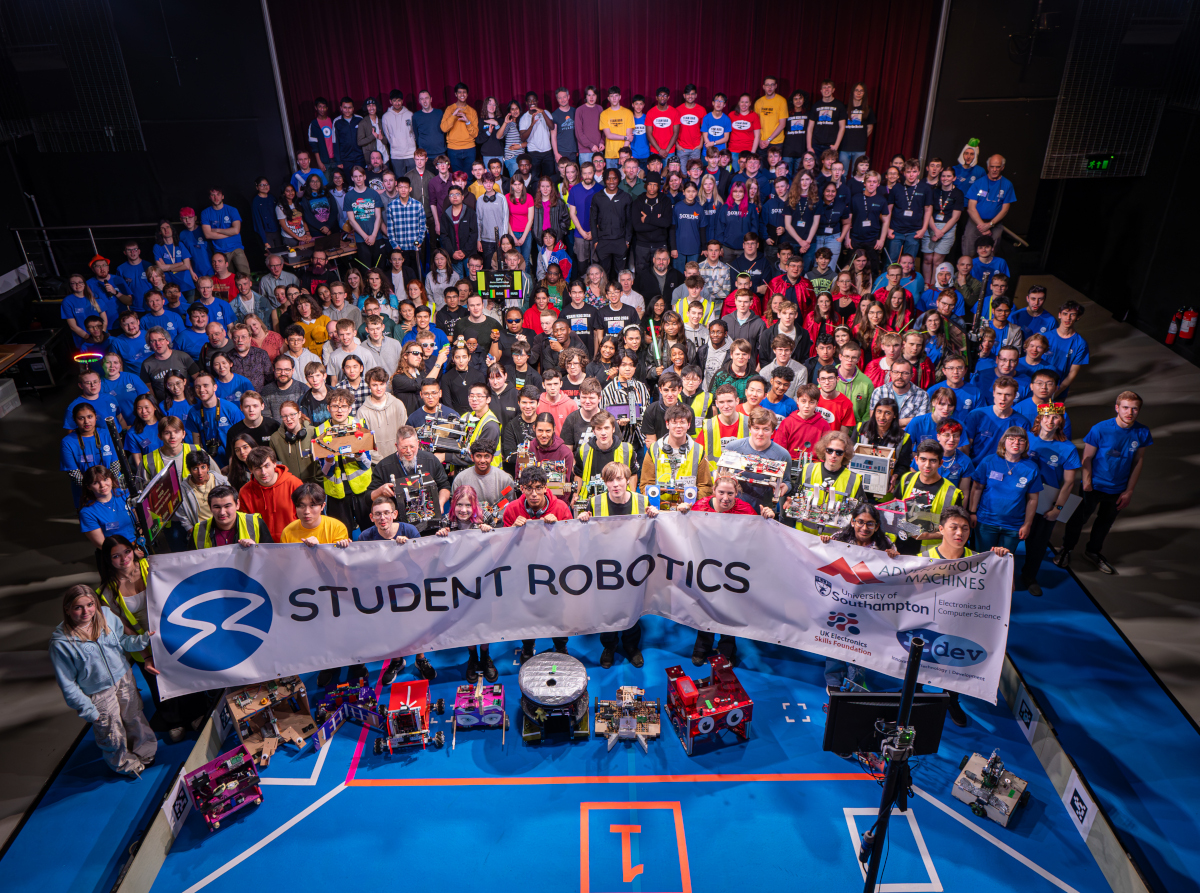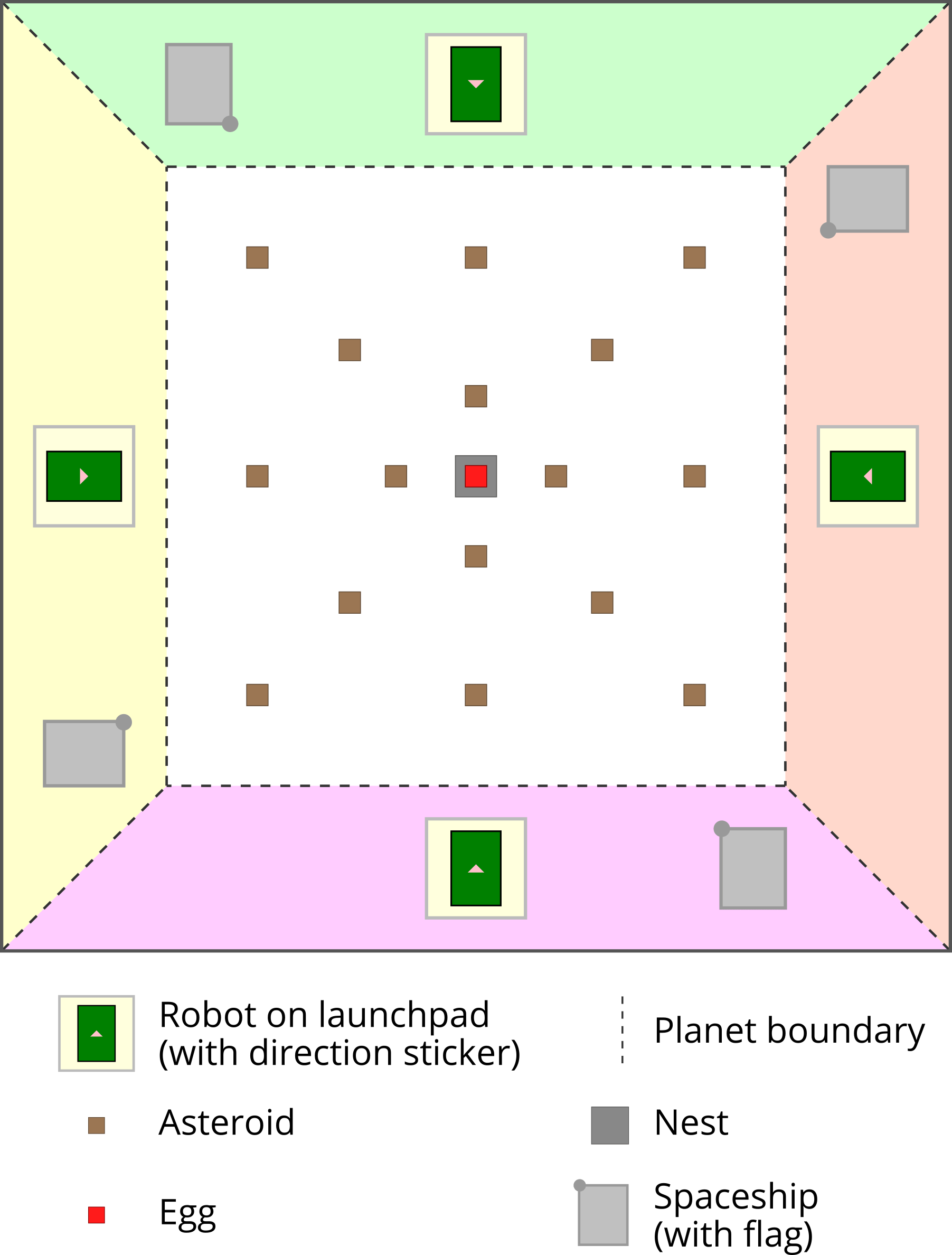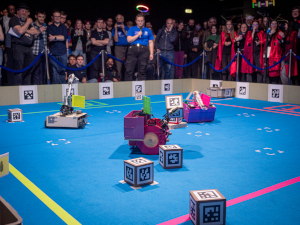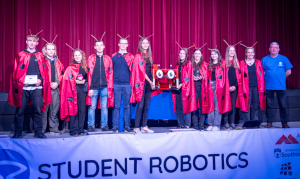
Gymnasium Markt Indersdorf took 1st place in Student Robotics 2024 after an exciting final match against The Ladies’ College Guernsey, Headington School and Wisbech Grammar School. All the teams have worked amazingly hard over the past six months to design, build & program their robots and it was great to see them compete.
The game: Final Frontier

This year’s game, Final Frontier, plunged teams into an interstellar battle for dominance between four formidable civilizations, all vying for control of the cosmos. Teams had to retrieve Asteroids scattered throughout the Asteroid field and transport them back to their home Planet or, even better, their intergalactic Spaceship currently under construction.
However the stakes are high as within the confines of the asteroid belt lies The Egg – a cosmic time bomb that, if disturbed, would spell chaos. Teams had to strategise, navigate the treacherous field, and decide whether to safeguard their own civilization or sabotage their rivals. With Asteroids worth points, Spaceships to manage, and The Egg lurking, the universe had never been this competitive.
Challenges
Following on from last year’s success, this year’s competition offered teams a set of Challenges to be completed throughout the competition year. These encouraged teams to start work on their robots early and covered movement, mechanics, and vision. They could be approached in any order, and completing challenges before certain deadlines earned the teams bonus league points.
Virtual Competition
The first part of our league this year was a virtual competition, broadcast live in March. Across twenty-one matches, teams competed in a simulated version of the main competition, testing their coding skills against one another. Wisbech Grammar School offered the best performance on the day, coming 1st in all four of their matches, though the team from Haberdashers’ Schools remained at the top of the leaderboard due to points they’d earned from the Challenges.
League Matches
During the in person event teams participated in a further 69 league matches, allowing the robots to improve and evolve both their construction and strategies. The robots displayed impressive agility, precision and ingenuity as they navigated the arena to capture Asteroids (and Spaceships in some cases) as well as outmanoeuvre their opponents.
At the end of the league there were only two league points separating the top three teams (The Ladies’ College Guernsey, Wisbech Grammar School and Royal Grammar School Guildford), with the next few teams not far behind.
Knockouts
The knockout rounds saw teams from the league matches pitted against one another in intense, high-stakes battles. With each round, the competition grew fiercer, and the robots were pushed to their limits as they raced to collect tokens and secure their place in the finals.
The Final

The thrilling final featured four teams which had shown consistent performance throughout the earlier stages and included teams from three schools which have previously won Student Robotics, so it promised to be exciting even before it started.
In a surprise move at the start of the match Wisbech Grammar School immediately captured The Ladies’ College’s Spaceship. This appeared to confuse The Ladies’ College’s robot, though it soon switched to placing Asteroids on its Planet instead. Meanwhile Gymnasium Markt Indersdorf managed to get a token into their own Spaceship, giving them a commanding lead.
The Ladies’ College and Headington School each captured two Asteroids, however Headington School’s robot gifted The Ladies’ College a third in the late stages of the match. Wisbech Grammar School’s consistent performance let them capture four Asteroids, and might have been enough to win had Gymnasium Markt Indersdorf not also captured some Asteroids into its robot.
Wisbech Grammar School were the source of another tense moment near the very end of the match when they attempted to steal The Ladies’ College’s first Asteroid, however they were unable to navigate off the Planet in time meaning that the Asteroid still scored for The Ladies’ College.
Results
- Winner: MAI – Gymnasium Markt Indersdorf
- 2nd place: WGS – Wisbech Grammar School
- 3rd place: TLC – The Ladies’ College, Guernsey (award sponsored by University of Southampton ECS)
- Excellence in Engineering award: ABS – Abingdon School (award sponsored by UK Electronics Skills Foundation)
- Rookie award: HBS – The Henry Box School
- Robot and team image award: MAI – Gymnasium Markt Indersdorf (award sponsored by ITDev)
- Online presence award: WMC – Westminster City School (Instagram, TikTok)
- Challenges award: RGS – Royal Grammar School Guildford
In the thrilling final, Gymnasium Markt Indersdorf triumphed over their opponents to win the Student Robotics 2024 competition. Meanwhile Wisbech Grammar School’s cunning tactics allowed them to edge out The Ladies’ College and Headington School.
The Excellence in Engineering Award is given to the team that displays the most extraordinary ingenuity in the design of their robot. As engineers, we appreciate elegance, simplicity, and robust engineering. This year the Excellence in Engineering award was given to Abingdon School for their robot’s precise use of Mecanum wheels and conveyor belt to take their Spaceship into the Asteroid field and fill it with Asteroids before returning to their home Planet.
We’re always delighted to welcome new teams to Student Robotics and understand how big a challenge it can be without prior experience. To recognise this additional challenge, we award the Rookie Award to the highest placed newcomer in the league, celebrating their incredible achievement. This year’s recipient was The Henry Box School with their very compact robot which used Meccano arms in its quest for Asteroids.

We award the Robot and Team Image Award to the team that presents themselves in the most outstanding way. As usual our teams rose to the challenge and we saw some fantastic themes! We loved The College of Richard Collyer’s thunder theme, which included competitors in face-paint, however the award for Robot and Team Image went to Gymnasium Markt Indersdorf for their stand-out ladybird theme. All team members had red capes with black dots and their red acrylic robot sported a pair of giant googly eyes.
Through social media, teams can share the problems they’re facing as well as their designs and successes. A few teams stood out to us this year with their regular uploads, but the winner of the Online Presence Award was Westminster City School for consistent and high quality posts throughout the year on multiple platforms. The judges were especially impressed by their video interviews at the competition event itself.
Check out the rulebook for all the details on the awards we give.
Media
If you would like to watch the competition back, the event was livestreams are available on our YouTube Channel:
- Saturday, Day 1: https://youtu.be/XhEUXg2m31k
- Sunday, Day 2: https://youtu.be/CpCC2fTn0os
The playlists for the soundtrack to the competition are also available:
Photos of the event have been added to our Google Photos Album.
Thank You
This year’s competition would not have been possible without all of our amazing sponsors. Their generous support allows us to make Student Robotics free to enter and help us continue in our mission to bring the excitement of engineering and the challenge of coding to young people through robotics.
Our SR2024 Sponsors
- The University of Southampton Engineering and Computer Science
- UK Electronics Skills Foundation
- Adventurous Machines
- ITDev
- Mythic Beasts
- Hexibox
We’re always looking to partner with more organisations. If you’d like to work with us, see our sponsor page.
Our Volunteers
We’d also like to thank our volunteers, who make Student Robotics happen every year! Some have helped at the competition itself, while others have been in teams working throughout the year to organise the event. Our Competition Team designs, organises, and delivers Tech Days and the Competition weekend. Our Kit Team designs and supports the software and hardware our competitors use; the Infrastructure Team ensures that our website stays up and our internal teams can work collaboratively; the Fundraising Team ensures that we have the resources needed to run our events; and the Marketing Team makes sure our efforts are seen and heard by all. A huge thank you to everyone who contributed to the success of this year’s competition.
If you’re reading this and want to join us next year, sign up on our volunteering page.
Notes to editors
Student Robotics is an annual robotics competition for 16-19 year-olds in the UK and Europe. It was founded in 2006 by university students and is free to enter thanks to our sponsors and many volunteers. Since it was first run in 2008, the final competition has grown from one room at the University of Southampton1 to the UK’s biggest autonomous robotics competition.
At the start of the academic year, teams are given a kit containing custom-made electronics at a Kickstart event, where the game for the year is announced. They then have until the Easter holiday to build fully-autonomous robots, which will compete against each other in the final competition. They are supported by volunteer mentors, and software to assist them in programming their robots is provided.
If you would like to find out more, please get in touch.
The SR Team
-
Student Robotics is independent from the University of Southampton. ↩
